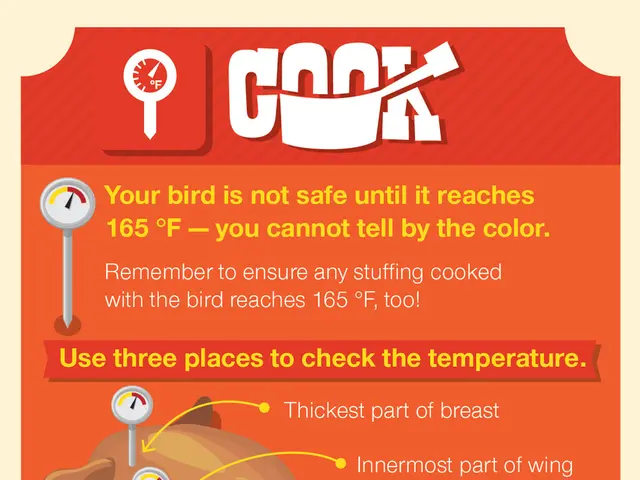Heart Discomfort: Could It Be a Heart Attack or 'Nutcracker Esophagus' Instead?
Swallowing down that troublesome lump in your throat just got a whole lot harder when you're dealing with a nutcracker esophagus, or as some call it, jackhammer esophagus. A condition hardly ever heard of, and even more rarely diagnosed, this annoying ailment can give you some serious chest pain and issues with swallowing, making you believe you're dealing with a heart attack or simple acid reflux.
Most doctors haven't encountered this condition, so it frequently goes unnoticed, often leading to misdiagnoses.
Dr. Scott Gabbard, a seasoned gastroenterologist, explains that nutcracker esophagus specifically affects the smooth muscles responsible for gliding food down your throat towards your stomach. It's like those muscles are being controlled by an overzealous mechanic who simply won’t stop pounding away. Esophageal spasm, a similar issue, causes the muscles to contract too rapidly, resulting in a jerky transport of food instead of a smooth journey.
Think of these conditions as rowdy cousins that ruin family dinner parties every year, says Dr. Gabbard. Normally, the swallowing process is a well-coordinated, gradual squeeze from the top of the esophagus to the bottom. But in nutcracker esophagus, the muscles contract too forcefully, and in esophageal spasm, they contract too rapidly, causing multiple problems.
So why the name "nutcracker esophagus"? Well, improved technology in manometry, a muscle test used to diagnose both conditions, has led to a new term, according to Dr. Gabbard. Older 2-D manometry tracings show a nutcracker pattern when the esophagus muscles squeeze too hard, causing the esophagus to close. Newer, high-resolution 3-D manometry tracings, however, reveal a strong, repetitive pattern that looks like the pounding of a jackhammer all the way down the esophagus in some patients.
Interestingly, the intensity of symptoms can vary greatly, with some patients experiencing severe chest pain that sends them rushing to the ER, while others may have no symptoms at all. When patients present with chest pain, doctors naturally rule out heart disease as the first step. They usually follow up with an upper endoscopy or prescribe anti-reflux medicine to see if acid reflux could be the culprit.
If pain and swallowing difficulties persist, however, doctors typically stop investigating and assume it's esophageal spasm, as manometry is the only way to diagnose these muscle disorders.
So, if you've been suffering from persistent chest pain and difficulty swallowing, don't settle for a simple acid reflux diagnosis. Instead, proactively ask your doctor for manometry and detailed investigation.
Once diagnosed, treatment options include:
- Medication – Calcium channel blockers relax the smooth muscle in both the arteries and the esophagus, providing relief for about 75% of patients. Some patients might not be able to tolerate these blood pressure medications.
- Peppermint Oil – For patients unwilling to take medication or who don't respond to it, Dr. Gabbard suggests trying peppermint oil. About half of those who can't tolerate blood pressure medicine respond well to peppermint oil and should also benefit from it when dealing with nutcracker esophagus.
- Botox® – When medications and peppermint oil don't work, botulinum toxin injections might be the solution. These injections can help stop the spasms in 90% of cases, but the effect only lasts for about a year.
- POEM – A procedure called Per Oral Endoscopic Myotomy (POEM) may be recommended for patients who respond well to Botox and want a permanent solution. This minimally invasive procedure involves making a small incision in the esophagus muscle to stop contractions. However, this procedure removes working muscle and relies on gravity to help drain food from the esophagus.
Resolving on its own or staying stable, nutcracker esophagus and esophageal spasm aren't likely to become anything worrisome, like cancer, fortunately.
These conditions can affect anyone, from the very young to the elderly, but they are relatively rare, affecting less than 1% of the population. Chronic use of opiates, such as those used to manage cancer pain, can increase the risk of developing these conditions.
In conclusion, if you're experiencing chest pain and difficulty swallowing, it's essential to rule out cardiac causes. If chest pain and swallowing difficulties don't improve after an endoscopy, be proactive, and discuss your symptoms with your doctor. Ask for manometry and a thorough investigation to rule out nutcracker esophagus or esophageal spasm.
- The troublesome lump in your throat may stem from a less known condition called nutcracker esophagus or jackhammer esophagus, often misdiagnosed due to a lack of awareness among doctors.
- Science and technology have played a significant role in the diagnosis of these rare conditions, with improved manometry tests revealing patterns indicative of nutcracker esophagus.
- A key issue with nutcracker esophagus is that it affects the smooth muscles responsible for moving food down the throat, causing an overzealous contraction akin to a jackhammer.
- In nutrition, certain medical conditions and chronic diseases, like neurological disorders or chronic use of opiates, could increase the risk of developing nutcracker esophagus.
- When it comes to health and wellness, maintaining fitness and exercise, skin care, and mental health are essential for overall well-being, but they shouldn't overshadow the importance of addressing unusual symptoms like chest pain and swallowing difficulties.
- The treatment landscape for nutcracker esophagus is diverse, with options ranging from medication to minimally invasive surgeries like POEM, and alternative therapies such as peppermint oil.
- When it comes to workplaces, workplace-wellness initiatives should be updated to include rare conditions like nutcracker esophagus to ensure proper awareness and early detection, ultimately improving employee health and productivity.
- Skin-conditions and dental health might not directly link to nutcracker esophagus, but maintaining overall health is crucial for long-term prevention and management of various medical conditions.
- As news spreads about nutcracker esophagus and its unique symptoms, it's essential to raise awareness and encourage open communication between patients and healthcare providers to ensure timely and accurate diagnoses.








